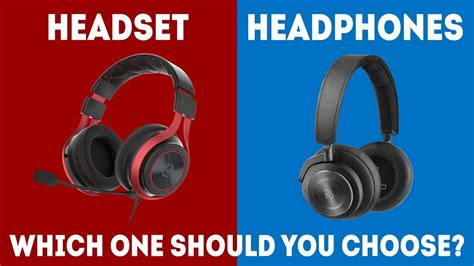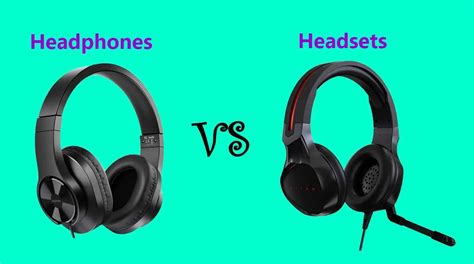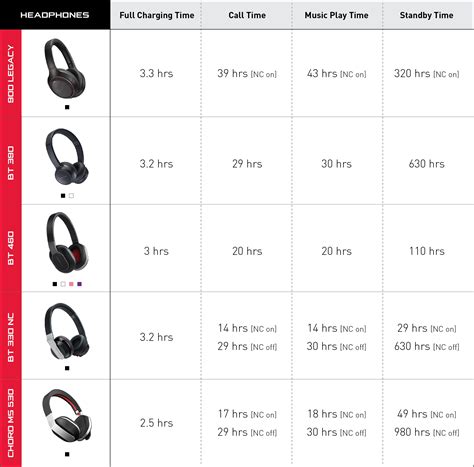In this article, we explore the unique features and functions that set headphones and headsets apart. While these two devices may seem similar at first glance, they differ in the way they enhance our audio experiences, providing distinctive attributes and catering to specific needs.
When it comes to personal audio devices, headphones and headsets are often used interchangeably. However, it is crucial to understand the subtleties of these terms to make an informed decision when purchasing audio equipment. Both headphones and headsets have their own merits, catering to various requirements and usage scenarios.
Headphones, often referred to as earphones or ear cups, are designed to immerse our ears in high-quality sound. They are primarily used for listening to music, podcasts, or any other audio content without any additional features. The focus of headphones lies solely on delivering exceptional sound quality, ensuring that every beat and note is crystal clear and accurately reproduced.
Conversely, headsets encompass the functionalities of headphones while incorporating a built-in microphone. This additional component allows users to engage in voice conversations, video calls, or gaming sessions seamlessly. Equipped with noise-canceling technology and adjustable microphones, headsets provide clear and uninterrupted communication, making them the go-to choice for individuals seeking both audio and voice capabilities.
Grasping the Fundamentals: Understanding the Essentials

When comparing headphones and headsets, it is important to delve into the core aspects that differentiate these two audio devices. While they may seem similar at first glance, a deeper understanding of their characteristics can shed light on their unique functionalities and purposes.
Headphones | Headsets |
|---|---|
These devices are primarily designed to deliver audio output directly to the user's ears. They provide a personal and immersive listening experience, enabling individuals to enjoy music, movies, or other audio content privately. | In addition to audio output, headsets also incorporate a microphone, allowing for two-way communication. They find extensive use in various scenarios, such as gaming, phone calls, virtual meetings, and other interactive activities that require both audio reception and transmission. |
Headphones typically come in over-ear, on-ear, or in-ear designs, each offering different levels of comfort, sound quality, and portability. They are often perfect companions for music enthusiasts seeking uninterrupted sonic immersion. | On the other hand, headsets commonly utilize an over-ear or on-ear design, incorporating a built-in microphone that can be positioned close to the user's mouth for clear voice capture. They provide a comprehensive audio solution for individuals engaging in voice-based activities. |
When using headphones, the primary goal is to consume audio content without the need for active participation, allowing users to enjoy their chosen media at their own pace and convenience. | Contrarily, headsets facilitate both audio consumption and communication, empowering individuals to actively engage in conversations, collaborate with others, or immerse themselves in gaming environments that demand both listening and speaking. |
The Sound Experience: How Sound Devices and Communication Devices Differ
When it comes to audio devices, there are two main categories that cater to distinct auditory needs: sound devices and communication devices. While both serve the purpose of delivering sound to the user's ears, they differ in their functionalities and specific applications.
Sound devices, commonly known as headphones, are designed to provide an immersive and high-quality audio experience. These devices are primarily utilized for personal entertainment, such as listening to music, watching movies, or playing video games. Headphones are equipped with advanced sound drivers and noise-canceling technologies, enabling users to indulge in a rich and detailed sound environment. They ensure an individualized audio experience, isolating the user from the external world and enabling them to focus solely on the audio content.
- Enhanced sound quality for an immersive audio experience
- Advanced sound drivers and noise-canceling technologies
- Ideal for personal entertainment: music, movies, and gaming
- Isolation from the surrounding environment
On the other hand, communication devices, also known as headsets, serve a different purpose altogether. These devices come with built-in microphones and are primarily used for communication purposes, such as making phone calls, participating in online conferences, or engaging in multiplayer gaming sessions. Headsets prioritize clear and effective communication, with their microphones designed to capture and transmit audio accurately. They often come equipped with features like noise-cancellation or adjustable boom microphones for better clarity during conversations.
- Incorporated microphones for communication purposes
- Ensures clear and accurate audio transmission
- Ideal for phone calls, online conferences, and multiplayer gaming
- Noise-cancellation and adjustable boom microphones for enhanced clarity
In summary, while both sound devices and communication devices provide audio output, their respective functionalities and targeted applications distinguish them from each other. Headphones focus on delivering enhanced sound quality and creating an immersive audio experience for personal entertainment, while headsets prioritize clear communication with the inclusion of built-in microphones and additional features tailored for communication purposes.
Design and Comfort: Choosing Between Headphones and Headsets

When it comes to selecting the perfect audio device for your needs, the design and comfort of headphones and headsets play a crucial role. The overall design and level of comfort can greatly impact your listening experience, making it important to choose the right option for your preferences.
- Design:
- Style: One key aspect of design is the style of headphones or headsets. Whether you prefer a sleek and minimalistic look or a bold and eye-catching design, there are options available to match your personal style.
- Portability: Headphones and headsets come in varying sizes and shapes, which directly affects their portability. If you are always on the go or traveling frequently, compact and foldable headphones might be a better choice. On the other hand, if you mostly use your audio device at home or in a stationary location, larger and more robust headsets might be a suitable option.
- Wired or Wireless: Another design aspect to consider is whether you prefer wired or wireless connectivity. Wired headphones can provide a stable and reliable connection, while wireless options offer freedom of movement without tangled cords.
- Comfort:
- Ear Cushions: The comfort of headphones and headsets largely depends on the quality and material of the ear cushions. Soft and plush cushions provide a comfortable fit and help reduce discomfort during extended periods of use.
- Headband: The headband is another crucial element of comfort. A well-padded headband distributes the weight of the headphones evenly across the head, preventing unnecessary pressure and discomfort.
- Adjustability: The ability to adjust the size and fit of headphones or headsets is essential for personalized comfort. Look for options with adjustable headbands or ear cup rotation to find the perfect fit for your head shape and size.
Consider your personal preferences and priorities when it comes to design and comfort, as this will ultimately guide your decision in choosing between headphones and headsets. Remember, finding the right combination of design, style, portability, and comfort will enhance your listening experience and ensure your satisfaction with your chosen audio device.
Versatility and Connectivity: Headphones vs. Headsets
When it comes to audio devices, there are distinguishing characteristics that set headphones apart from headsets, which relate to their versatility and connectivity capabilities. Understanding how these features differ can help users make an informed decision when choosing between the two options.
- Versatility: Headphones are primarily designed for providing an immersive audio experience, allowing users to listen to music or other forms of audio privately. They offer great portability and convenience, making them suitable for various activities such as commuting, exercising, or simply relaxing.
- Connectivity: Headphones typically utilize wired connections to audio devices, such as smartphones, computers, or music players, using a standard 3.5mm audio jack. In recent years, wireless headphones with Bluetooth technology have gained popularity, providing users with freedom of movement without the hassle of tangled cords.
- Versatility: On the other hand, headsets are designed not only to deliver high-quality audio but also to facilitate communication. They are equipped with a built-in microphone, enabling users to engage in voice calls, participate in online gaming, or interact with voice assistants. Headsets are particularly useful for those who need to communicate frequently while using audio devices.
- Connectivity: Headsets often come with additional connectivity options, such as USB or specialized connectors, allowing them to be easily connected to a wide range of devices. This makes them popular choices for professional use, especially in environments such as call centers or gaming setups where clear communication is crucial.
In summary, while headphones prioritize providing an immersive audio experience for personal enjoyment, headsets offer a combination of high-quality audio and communication capabilities. Choosing between the two depends on the specific needs and preferences of the user, as well as the intended usage scenarios.
Communication Features: The Distinction of Headsets

When it comes to the realm of personal audio devices, there exists a fascinating array of options for consumers to choose from. One particular subset of these devices, often overlooked but essential in certain contexts, are headsets. While headphones are widely recognized as a means of enjoying music or other audio content, headsets offer an additional set of communication features that make them indispensable in various professional and personal settings.
Headsets, unlike traditional headphones, incorporate a built-in microphone, enabling users to engage in two-way communication while also enjoying their audio experience. This distinctive feature presents a significant advantage in situations where clear and convenient communication is paramount.
To better comprehend the significance of these communication features, it may be helpful to consider some common scenarios where headsets shine. Imagine a busy call center environment, where agents handle a constant influx of customer inquiries. The use of headsets allows these professionals to keep their hands free, effortlessly juggling phone conversations while simultaneously accessing necessary information on their computers. This hands-free capability proves invaluable in enhancing productivity and efficiency, ultimately leading to better customer service.
Another scenario where headsets play a vital role is in online gaming. Gamers rely heavily on real-time communication with their team members during intense gaming sessions. A headset equips players with crystal-clear audio reception, allowing for seamless coordination and strategizing. The ability to communicate instantly and accurately can make the difference between victory and defeat in these competitive gaming environments.
Moreover, headsets extend their utility beyond the professional and gaming realms. One notable example is their inclusion in virtual reality systems. By integrating headsets with VR technology, users can interact with immersive virtual environments while simultaneously communicating with others in the same virtual space. This adds an entirely new dimension to the virtual reality experience, enhancing its social aspect and facilitating collaboration.
In conclusion, while headphones undeniably serve as a means of personal audio enjoyment, headsets distinguish themselves by incorporating communication features. The ability to seamlessly switch between passive audio consumption and active communication proves invaluable in a variety of professional, gaming, and even virtual reality settings. Headsets enable users to stay connected, collaborate effectively, and enhance their overall audio experience in a truly unique way.
Gaming and Multimedia: Optimal Choice for Headphones or Headsets
When it comes to gaming and multimedia experiences, selecting the perfect audio solution is of utmost importance. Whether you are a avid gamer or a multimedia enthusiast, having the right equipment can greatly enhance your overall experience and immerse you in the virtual world. In this section, we will explore the ideal choice between headphones and headsets for gaming and multimedia purposes.
- Superior Audio Quality: Both headphones and headsets can deliver high-quality audio, enabling gamers and multimedia users to enjoy every sound detail with precision. However, each option offers its unique advantages in this aspect.
- Immersive Gaming Experience: Gaming headphones and headsets both contribute to creating an immersive gaming experience. They provide excellent audio output, allowing users to hear every footstep, explosion, and dialogue, enhancing the overall gaming ambience.
- Comfort and Convenience: Comfort is of great importance during long gaming sessions or movie marathons. Both headphones and headsets offer varying degrees of comfort, which largely depend on the design, materials used, and individual preferences.
- Communication Capabilities: In multiplayer gaming or online meetings, clear communication with teammates or colleagues is vital. This is where headsets excel as they come equipped with built-in microphones, facilitating effortless communication without the need for additional accessories.
- Versatility in Usage: While headphones are primarily designed for audio playback, headsets offer the advantage of being multipurpose devices. They not only provide audio output but also enable users to communicate effectively, making them suitable for both gaming and multimedia purposes.
Considering these factors, it becomes clear that choosing between headphones and headsets for gaming and multimedia depends on individual preferences and requirements. Whether you lean towards a more immersive audio experience or prioritize communication capabilities, there is a suitable option available to elevate your gaming and multimedia activities.
Price Range: Comparing the Costs of Headphones and Headsets

In this section, we will explore and compare the price ranges of headphones and headsets, delving into the various factors that contribute to their cost differences. Having an understanding of the pricing dynamics can help consumers make informed decisions when purchasing either of these audio devices.
- 1. Brand Reputation: Reputable brands often command higher prices due to their commitment to quality and reliability.
- 2. Audio Quality: Headphones and headsets with superior audio quality generally come at a higher price point, as they use advanced technologies and components to deliver an enhanced audio experience.
- 3. Features and Functions: The presence of additional features such as noise cancellation, wireless connectivity, and built-in microphones can increase the price of both headphones and headsets.
- 4. Design and Durability: Aesthetically appealing designs and durable construction materials often contribute to higher prices as they enhance the overall user experience and longevity of the product.
- 5. Gaming and Communication Capabilities: Headsets designed specifically for gaming or communication purposes tend to have specialized features and technology, making them more expensive compared to regular headphones.
- 6. Wired vs. Wireless: Generally, wireless headphones and headsets are more expensive than their wired counterparts due to the added convenience and freedom of movement they offer.
- 7. Market Demand and Competition: The law of supply and demand plays a role in pricing. If a particular brand or model is highly sought after and faces limited competition, it may have a higher price tag.
When deciding between headphones and headsets, it is important to consider your specific needs, preferences, and budget. By understanding the price range and its determining factors, you can make a well-informed decision that aligns with your audio requirements and financial capabilities.
Final Considerations: Choosing the Right Option for You
As we conclude our exploration of these two audio accessories, it is important to take into account the unique features and functionalities they offer, alongside personal preferences and needs. The decision to invest in either headphones or headsets is a subjective one, dictated by individual tastes, requirements, and usage scenarios.
When making the right choice, it is essential to consider the primary purpose for which you will be using the audio device. Are you looking for a high-quality audio experience while immersing yourself in your favorite music or movies? Or do you require a headset that incorporates a microphone for clear communication during online gaming or virtual meetings?
Headphones, with their sleek and lightweight design, are often favored by audiophiles and those seeking an immersive audio experience. They provide an enhanced sound quality, allowing for a more detailed, crisp, and balanced sound output. Moreover, headphones are generally more compact and portable, making them a convenient choice for everyday use, whether at the office, gym, or during commutes.
On the other hand, headsets, with their integrated microphones, cater to individuals who demand both audio quality and robust communication capabilities. Headsets are widely used by gamers, allowing for crystal-clear voice communication, a crucial aspect for team coordination and immersion in the gaming world. Additionally, headsets are also extensively utilized in professional settings, facilitating seamless virtual meetings and conference calls.
Ultimately, the choice between headphones and headsets relies on personal preferences and specific usage scenarios. It is important to consider factors such as sound quality, comfort, durability, price, wireless connectivity, and additional features to make an informed decision. While headphones offer superior audio quality and portability, headsets provide the added advantage of a built-in microphone for clear communication.
By carefully evaluating your audio needs, researching product specifications, and considering expert reviews, you can confidently choose the option that best aligns with your preferences and lifestyle. Whether you prioritize an exceptional audio experience or seamless communication, both headphones and headsets offer remarkable solutions to enhance your auditory journey.
[MOVIES] [/MOVIES] [/MOVIES_ENABLED]FAQ
What is the main difference between headphones and headsets?
The main difference between headphones and headsets lies in their functionality. Headphones are primarily used for audio listening, while headsets combine headphones with a microphone for audio input and output.
Can I use headphones for gaming or communication purposes?
Yes, you can use headphones for gaming or communication purposes, but they do not have a built-in microphone like headsets. If you need to communicate with others during gaming or for video calls, it is recommended to use a headset.
Are headsets more expensive than headphones?
The price of headsets and headphones can vary depending on the brand, quality, and additional features. Generally, headsets tend to be slightly more expensive than headphones with similar audio quality due to the inclusion of a microphone.




